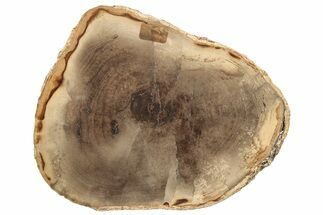This Specimen has been sold.
8.3" Tall, Petrified Wood Bookends - Sweet Home, Oregon
This is a gorgeous pair of bookends made from Lower Oligocene-aged petrified wood from Sweet Home, Oregon. The bookends have been polished on their outer face and have felt lined contact edges. Exceptional polishing work on this pair.
Each bookend slightly varies in size, with one measuring 8.3" tall, 5.75" wide and 1.65" thick, while the other is 7.9" tall, 5.2" wide and 1.7" thick.
Each bookend slightly varies in size, with one measuring 8.3" tall, 5.75" wide and 1.65" thick, while the other is 7.9" tall, 5.2" wide and 1.7" thick.
What Is Petrified Wood
Petrified wood is the name given to wood that has been turned into stone (fossilized) through the process of permineralization. In this process, all of the organic matter becomes replaced by minerals, while much of the original structure, such as tree rings, is retained. For this to happen, the wood needs to be buried in an environment low in oxygen to prevent decomposition and with flowing, mineral-laden water, so minerals may replace structures. The coloration is caused by various minerals that present in that water during fossilization. For example, red colors are due to iron compounds, greens due to copper, and so on.
Petrified wood is the name given to wood that has been turned into stone (fossilized) through the process of permineralization. In this process, all of the organic matter becomes replaced by minerals, while much of the original structure, such as tree rings, is retained. For this to happen, the wood needs to be buried in an environment low in oxygen to prevent decomposition and with flowing, mineral-laden water, so minerals may replace structures. The coloration is caused by various minerals that present in that water during fossilization. For example, red colors are due to iron compounds, greens due to copper, and so on.
SPECIES
Unknown
AGE
LOCATION
Sweet Home, Oregon
SIZE
8.3 tall, 5.75" wide, 1.65" thick
CATEGORY
SUB CATEGORY
ITEM
#307938
We guarantee the authenticity of all of our specimens.
 Reviews
Reviews












